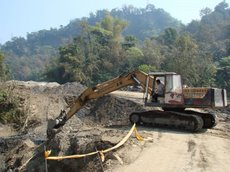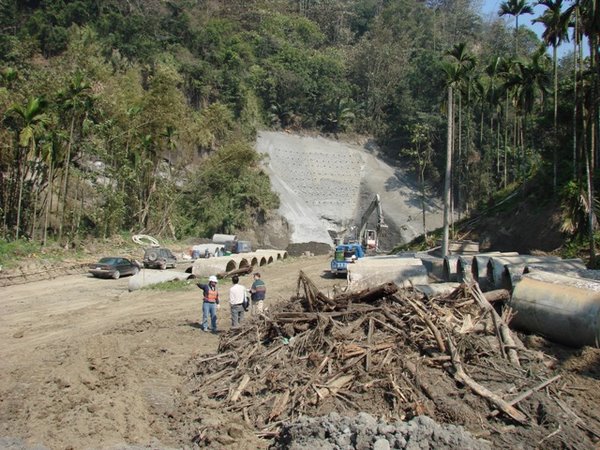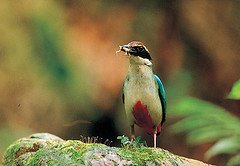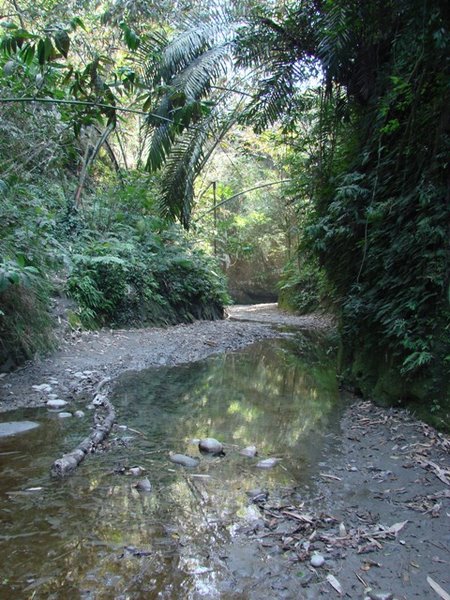By S.C. Wu and Ching-chun Chen
Board of Directors, Wild Bird Society of Yunlin, Taiwan
The Hushan Dam site is located in a geologically unstable and earthquake-prone area in central Taiwan. It is designed as part of an off-stream reservoir, which would store fresh water drawn via a 6.9 kilometers pipeline over the hills from the Chingshui River in neighboring Nantou County. The dam will flood 422 hectares of a wilderness area. Two groups of residents, the migrant Fairy Pitta and the resident Taiwan indigene, are at the mercy of proponents of the project, and can only be saved by a wise choice from the government and immediate action from the conservationists near and far against the dam project.
The Fairy Pitta (Pitta nympha) is a migratory bird that chooses to feed and breed in Taiwan every summer. Its population in Yunlin County was around 159 individuals in 2001, and 173 and 108 individuals in 2001 and 2002, counted by the Wild Bird Society of Yunlin County and the Endemic Species Research Institute of COA (Council of Agriculture of Taiwan) respectively. Sadly, with this relatively small population, the dam site has been found to be the most densely populated area of Fairy Pitta ever known in the world. Because of this rarity, the Fairy Pitta was designated as an endangered species under Taiwan’s Wildlife Protection Act, as well as listed as a vulnerable bird by Birdlife International and IUCN (International Union for the Conservation of Nature), and regulated under CITES (Convention on International Trade in Endangered Species). This piece of wonderland is a safe haven not only to the Fairy but also to other indigenous residents.
Endemic species and subspecies such as Maroon Oriole (Orilus traillii), Swinhoe’s Pheasant (Lophuras swinhoii), Farmland Treefrog (Rhacophorus arvalis) and Spotted Scops Owl (Otus spilocephalus) have also been photographed in this area, although they are rarely spotted. Crested Serpent Eagles (Spilornis cheela) circle high in the sky searching for food almost every day, which reveals the vastness of territory needed to maintain their trophic level high up in the food chain.
Formosan Rock Macaques (Macaca cyclopis) wander about in groups and are regarded as burglars by the farmers, but at least there is a place beyond the orchard fence, in the forest, to which they can retreat to rest for the night. One wonders just how this area came to sustain such a diversity of lives. Just take a walk into one of the two remaining wild woods within the dam site, and the secret book of Taiwan’s biodiversity is there for you read.
Taiwanese indigene should be protected rather than being erased from the surface of earth. This country has been pushing up by tectonic movements. Rocks on the numerous summits are worn down and break away, rolling down to the plains to form the layers of pebbles and sand known as the Pleistocene Toukoshan Formation. This formation is one the birthmarks of Taiwan. Another relates to the four ice ages that have occurred in the 2.5 million years that have passed since this land emerged from the sea. Between the advance and retreat of each ice age, various species have come here from north and south to dwell and flourish, sometimes leaving again and sometimes dying in Taiwan.
Some temperate species have managed to survive around the summits, while other, tropical species are found lower down the mountains; all in all, a great variety species have settled down along the profile of almost every mountain in Taiwan. The discovery of a patch of wild coniferous trees inside the dam site strongly supports this theory. Excavation of the dam site would diminish both of these birthmarks, leaving no trace for the Taiwanese people to identify with.
The principles of social justice should be upheld. The building of this dam will cost taxpayers billions of NT dollars, i.e. NT$20~30 (US$0.63~0.86) for every tonne of raw water supplied, as opposed to the NT$11 or less per tonne for which it will be sold to the companies of the Yunlin Offshore Industrial Park. In contrast, a desalination plant could produce fresh water for around NT$20 or less per tonne. The public subsidy of this environmentally destructive project and of the industries that generate pollution and devour energy and water is totally and absolutely against the principle of social justice.
Conclusion:
Our plea is to stop the Hushan Dam project. This is essential to the preservation of the environment, and hence the natural identity, of Taiwan. No only should this be done for the sake of generations of humans to come, but also for the sake of the Fairy Pitta and other wildlife indigenous to Taiwan, with which we still share this habitat.
Saturday, May 5, 2007
Stop the Hushan Dam, Save the Fairy Pitta and Taiwan Indigene
Posted by
Wild at Heart Legal Defense Association
at
4:11 PM
![]()
Subscribe to:
Post Comments (Atom)








No comments:
Post a Comment